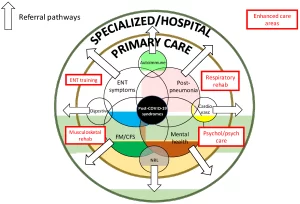
Abstract
Long COVID-19 may be defined as patients who, four weeks after the diagnosis of SARS-Cov-2 infection, continue to have signs and symptoms not explainable by other causes. The estimated frequency is around 10% and signs and symptoms may last for months. The main long-term manifestations observed in other coronaviruses (Severe Acute Respiratory Syndrome (SARS), Middle East respiratory syndrome (MERS)) are very similar to and have clear clinical parallels with SARS-CoV-2: mainly respiratory, musculoskeletal, and neuropsychiatric. The growing number of patients worldwide will have an impact on health systems. Therefore, the main objective of these clinical practice guidelines is to identify patients with signs and symptoms of long COVID-19 in primary care through a protocolized diagnostic process that studies possible etiologies and establishes an accurate differential diagnosis. The guidelines have been developed pragmatically by compiling the few studies published so far on long COVID-19, editorials and expert opinions, press releases, and the authors’ clinical experience. Patients with long COVID-19 should be managed using structured primary care visits based on the time from diagnosis of SARS-CoV-2 infection. Based on the current limited evidence, disease management of long COVID-19 signs and symptoms will require a holistic, longitudinal follow up in primary care, multidisciplinary rehabilitation services, and the empowerment of affected patient groups.


